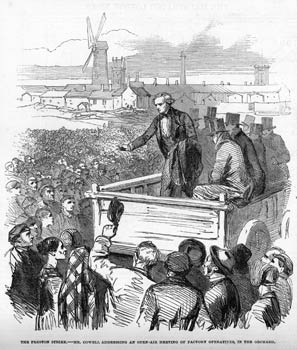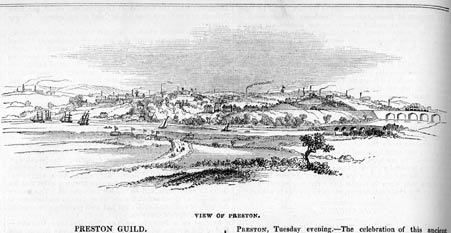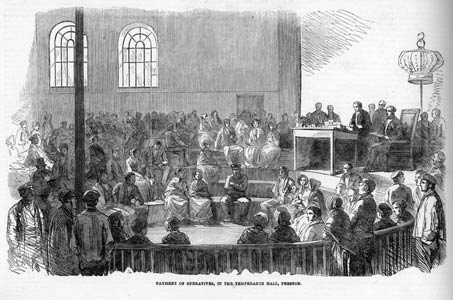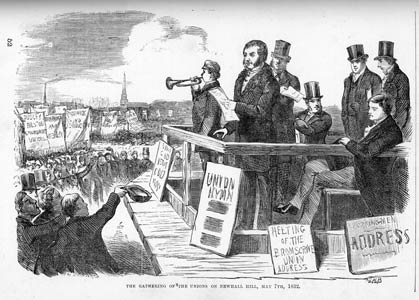|

NOTES ON ISSUE 6: HISTORICAL GLOSSARY
PART 1 OF 3
Printable View
"Oh,
my friends, the down-trodden operatives of Coketown! Oh, my
friends and fellow-countrymen, the slaves of an iron-handed
and a grinding despotism! Oh, my friends and fellow-sufferers,
and fellow-workmen, and fellow-men! I tell you that the hour
is come when we must rally round one another as One united power…"
Dickens's union orator, Slackbridge, whose words open this installment of Hard Times, is partly based on Dickens's own observations during the 1853-54 strike in Preston, a Lancashire cotton town. One of its leaders, Mortimer Grimshaw, inspired the portrayal of Slackbridge, which is notable for Dickens's air of hostility toward the union leader—despite his support for the workers' plight generally.
The lengthy Preston strike was heavily covered in the press at the time. Another prominent (and less inflammatorily radical) leader of the strike, George Cowell, was depicted speaking to the striking workers in the Illustrated London News of November 12, 1853, as shown below.

The illustration was titled "The Preston
Strike—Mr. Cowell addressing an open-air meeting of factory
operatives in the Orchard." A view of the town of Preston itself
appeared in the Illustrated London News on September
10, 1842. 
"Good!" "Hear, hear, hear!" "Hurrah!"
and other cries, arose in many voices from various parts of
the densely crowded and suffocatingly close Hall, in which the
orator, perched on a stage, delivered himself of this and what
other froth and fume he had in him.
The "hall" Dickens describes here is
based on the Temperance Hall in Preston, which he saw on his
stay in Preston. During the strike there, workers regularly
held meetings of delegates in the hall on Sundays, and on Mondays
the striking workers received their relief payments there. This
depiction of Temperance Hall during the strike, showing the
distribution of these payments, appeared in the Illustrated
London News on November 12, 1853.

resolve for to subscribe to
the funds of the United Aggregate Tribunal, and to abide by
the injunctions issued by that body for your benefit, whatever
they may be
At the time Dickens wrote, unions tended
to be occupation-specific. In the Lancashire cotton industry,
for instance, there were associations for power loom weavers,
spinner, and so on, some of which were short-lived. During the
Preston strike, however, the various trade unions of the area
worked cooperatively and with efficiency to coordinate their
demands. Here, the union organizer Slackbridge seems to be calling
for a general union that would bring all the trades together
into a "united aggregate tribunal." Dickens, who drew heavily
on his observations of the Preston strike for this episode,
may also have been thinking of a strike of engineers that took
place in 1852. That strike was called by a large and prestigious
union, the Amalgamated Society of Engineers, which was portrayed
in the press as despotic.
The idea that smaller unions might combine into large and extremely
powerful organizations across many trades, industries and regions
fed bourgeois Victorian fears of a workers' revolt. Here, Slackbridge's
rhetoric may underscore that fear, as he calls upon the workers
to join and to "abide by the injunctions" issued by the union,
"whatever they may be." Nevertheless, workers and organizers
had from an early time seen the benefit in working cooperatively,
and they would continue to do so. One large union meeting, which
took place in Birmingham in 1832, is depicted in Robert Kirkup
Dent's Old and New Birmingham (1880).

|

